Check it out!
In early December I was invited, along with several other writers, to New Hampshire’s SIG SAUER to check out a completely new pistol they planned to release in early 2018. Today, I get to share what I saw when they they sat us down for the big reveal. Meet the SIG P365.
The name explains the pistol’s intent, as a concealed, everyday carry sidearm. SIG refers to this 9mm as a High-Capacity Micro-Compact pistol.
The basic stats are impressive; the P365 measures 1″ wide, 5.8″ long, and 4.3″ tall with a barrel length of 3.1″. It also weighs just 17.8 oz with an empty magazine. Now comes, the beauty part; the standard magazine capacity is 10 rounds.
Development
When they decided to develop this pistol, SIG looked at the three attributes of pistols intended for concealed carry; Concealability, Capability, and Capacity, evaluating what was already available in the market.
Here’s how the P365 stacks up compared to the footprint of other, similar pistols.
This graphic offers a size comparison between various compact pistols and the P365.
SIG invested two years to develop the P365, but all of that started with an initial six months working on the magazine. The engineers considered where they could make the biggest impact and decided capacity was key, so long as they could maintain in the other areas as well. Consequently, they started with the magazine. Essentially, designing the pistol around the magazine. It’s not a full double stack, nor a single stack, but rather something in between, a narrow neck. SIG has three patents pending for this new design which allows the P365 to be as narrow as it is.
The pistol comes with a 10 round flush magazine as well as a 10 round extended version. The 12 round extended magazine is available as an after market add-on accessory.
Attributes
I want to be very clear that this is not a repackaged P320, although you can see that they are related. As you can imagine, the internals are very similar to the P320, with a fire control unit which is serialized.
The P365 frame offers a high grip to bore axis to reduce perceived recoil. The grip is fully-textured polymer with a slim-line rail. Additionally, the Nitron coated stainless-steel slide comes standard with front and rear serrations for slide manipulation, as well as SIGLITE night sights.
Testing
Based on their experience with the P320, SIG developed an entirely new, enhanced drop test protocol for duty handguns. They dropped the P365, 574 times in 26 orientations as well as five drops at 6 feet on concrete.
For those of you are wondering if this new test protocol is going to be retroactive to older pistol models, it isn’t. However, any new models will be subjected to this protocol during development.
Additionally, they’ve put over 40,000 rounds through a P365 with no frame cracks.
Ron Cohen’s Remarks
SIG CEO Ron Cohen is very proud of his company’s R&D investment. He stated that they spend four to fives times as much of their competitors and as time has gone on they’ve begun to rely more heavily on analytical and modeling work, citing a recent teaming agreement with nearby MIT. He went on to say, “We built this pistol around our new, proprietary magazine for maximum concealability, capacity and shootability. The P365 is a pistol for professionals and civilians alike who want a smaller, high-performance pistol that does it all. This is the ultimate, everyday concealed carry pistol.”
During his remarks, Ron Cohen also mentioned that the P365 could very well replace full size pistols in many agencies. The reason so many carry full sized, double stacked pistols, is so that they have access to more rounds. He might be on to something.
As an interesting aside, the SIG marketing team gave us a look at how they plan to market the P365.
But Does It Shoot?
Over the course of two days, I was able to fire about 1000 rounds through the pistol. On the first day, we fired outdoors, at SIG Academy’s famous Area 51. When they had initially planned on holding the event, the weather was much milder. However, on that day, conditions were extremely cold.
At one point, I checked the app on my phone and it said that it felt like 8 degrees.
Although it was cold, the pistol was comfortable to shoot. One of the things that has always bothered me about compact pistols is that I don’t feel like I’m getting a proper grip. One of the things SIG has done with the P365 is that it has a more pronounced trigger undercut bringing the grip higher and offering more contact with the pistol. Even though it’s not as concealable, the 12 round magazine allowed a full grip for me, especially with gloves on, while the 10 round flush magazine felt like my pinky finger didn’t quite get full purchase. I like the third option, the 10 round extended magazine, a great compromise between grip, concealability and capacity.
Unfortunately, with at least one round in every magazine on that first day, the pistol failed to completely go into battery. Initially, SIG employees told me I was limp wristing the pistol. As I was wearing gloves and it was very cold, I figured we’d see if that was actually the problem once we were inside on the second day. However, it turned out that all of the press, and a couple of SIG personnel shooting the pistol that day, experienced the same issue.
I really appreciated the front and rear slide serrations as I was wearing gloves and worked out how to best manipulate the slide while loading the pistol and reducing malfunctions.
That evening, they cleaned the weapons, stripped the lubricant and replaced it with Slip 2000. Although I asked which lubricant was used on that first day, oddly, no one seemed to know what was used.
The second day was indoors where the writers participated in an abbreviated concealed carry course presented by the great instructors of SIG Academy.
We began each scenario with dry fire and progressed to timed engagement of multiple targets, with new targets being revealed as the scenario progressed. In addition to restaurant situations, we also fired from and around a vehicle which was rolled into the range.
The failure to go into battery issues went away. In fact, I had zero malfunctions and I fired three times as many rounds in the second day as the first. Based on this, I’d say that the lubricant used the first day was not appropriate for the environment. It’s an important issue which few consider until they are in that situation.
Additionally, firing was all barehanded and the texturized grip felt great. It was aggressive enough that I wouldn’t want to change it, but not so much that it annoyingly chaffed. The controls were easy to manipulate except for the magazine release which required me to adjust my grip slightly.
Accessories
As far as accessories go, the P365 has a slim-line rail. SIG has planned for a weapon light and laser which fit this rail, to be offered by SIG Optics. The light will be available sometime this Spring with the laser coming later in the year. SIG also has a Lima grip with its integrated laser, under development. Although the Lima grip is user swappable, SIG doesn’t want to refer to the P365 as modular. At least, not yet. It is however, user configurable. Interestingly, SIG informed me that they will offer a suppressor for the P365. Although they haven’t offered any additional details, I would imagine that it will require a threaded barrel.
As it’s intended as a concealable pistol, you’re going to need a holster. While the P365 will fit several generic holsters, SIG has worked with Black Point to offer a fully ambIdextrous holster which can be configured for Inside the Waist Band or belt carry. They also offer a magazine pouch.
Overall Impressions
Although there were hiccups on the first day, I consider the P365 reliable, at least based on my limited interaction. Unfortunately, due to the range scenarios we had access to, I can make no determination regarding accuracy. The concealed carry phase concentrated on exposing us to a range of scenarios, but based on those scenarios, I feel that the biggest advantage of the the P365 was the ability to engage multiple targets, with multiple rounds, without reloading. No other pistol of this size offers that.
I think the P365 is going to prove very popular. With the 12 round extended magazine, plus one up the pipe, you’ve got yourself a full capacity pistol in a package you can actually conceal. There’s no compromise, at least in caliber or capacity. It fires 9mm cartridges including +P rounds. I plan on purchasing one, as my first SIG handgun, once they are available.
According to SIG, the P365 has been in production for several months and should be available very soon. Their concern is keeping up with demand for a pistol that has broken the mould for a carry pistol, combining concealability with capacity.
Photos by Richard King Photography.
WESTFIELD, Massachusetts – January 3, 2018 – Savage firearms is pleased to unveil a refreshed version of its legendary Model 110 series rifles that takes fit, form and function to new heights. The updated Model 110 lineup features a fresh look and the all-new user-adjustable AccuFit system. Savage will launch the new lineup at the 2018 SHOT Show January 23-26 at the Sands Expo Center in Las Vegas, Nevada.
The Model 110 series’ extreme makeover began as a cosmetic facelift focused on style and aesthetics, but soon grew into a quest to produce a platform that would allow hunters and other shooters to perfectly customize fit for ultimate accuracy, without a trip to a gunsmith. The result was the development of the revolutionary AccuFit system: www.savagearms.com/accufit.
AccuFit features adjustable components that allow users to custom-fit both comb height and length of pull. The only tool needed is a Phillips-head screwdriver.
“AccuFit makes it easy for shooters to achieve a fit that allows them to shoulder the gun and align their eye with the optics in a consistent manner, without having to move their head around to compensate for being the wrong height or distance from the scope,” said Beth Shimanski, Savage senior marketing manager. “The resulting combination of a solid cheek-to-stock connection, proper eye relief and comfortable, personalized fit add up to better shooting form and improved accuracy.”
Comb height is controlled by five riser settings, adjustable in 1/8-inch increments. “Simply select the riser that creates cheek-to-stock contact and aligns your line of sight parallel to the barrel or scope,” Shimanski explained. Length of pull is likewise fully adaptable to the shooter’s stature by using the four inserts included with the rifle.
“AccuFit is usually a set-and-forget system, but its versatility allows you to tailor length of pull and comb height as needed, such as when changing optics or donning bulky clothing for cold-weather hunting,” said Shimanski. “AccuFit also accommodates physical changes, making it the perfect youth gun that will grow with the shooter throughout a lifetime of use.”
Shimanski noted that AccuFit’s adaptability also increases the rifle’s resale value, because it can easily be customized to fit the new owner. Likewise, the gun can be adjusted as needed if the gun is handed down to a family member.
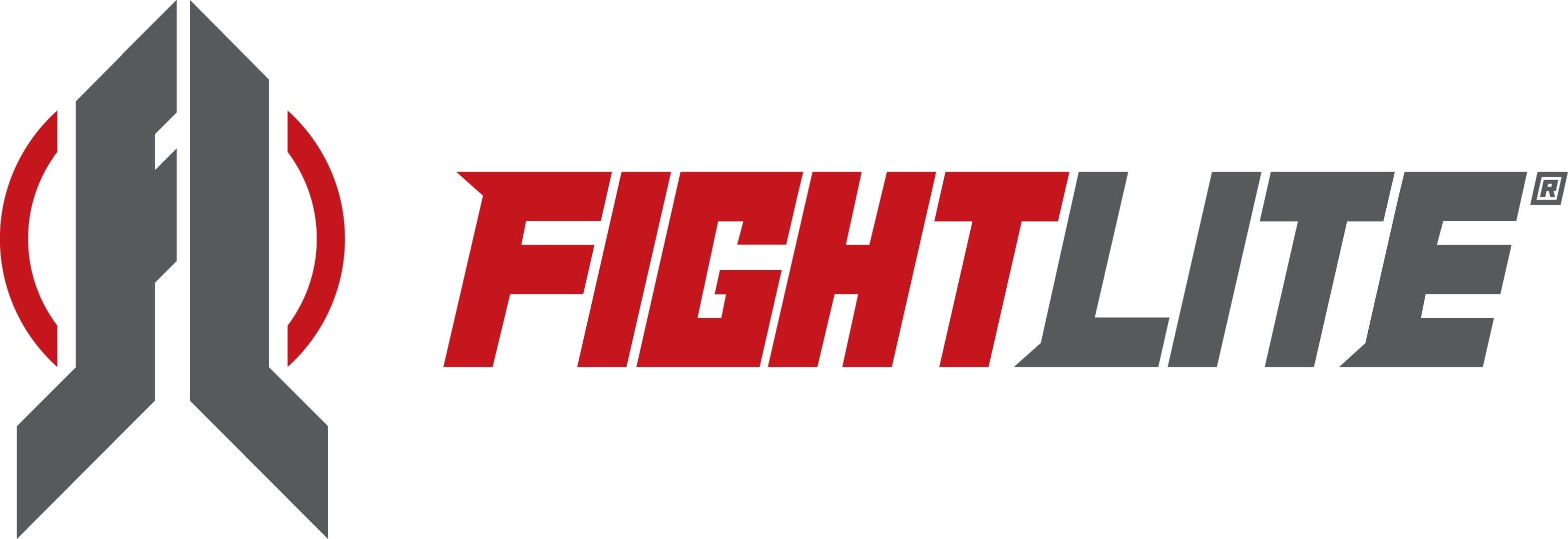
(Melbourne, FL) January 3, 2018 – FightLite® Industries, the country’s leading manufacturer of innovative, mission-configurable firearms, parts and accessories announces that it will be introducing some groundbreaking new products at SHOT Show this year in Booth #12971, located in the upstairs Main Hall, Level 2 Section of the show. The annual SHOT Show is being hosted at the Sands Convention Center in Las Vegas January 23-26, 2018.
FightLite® Industries is also hosting live-fire, full-auto range activities at the official SHOT Show Industry Day being held on Monday, January 22, 2018 at the Boulder Rifle and Pistol Club range facility and invites all attendees to shoot exclusive FightLite® products by visiting FightLite® Industries’ Full-Auto Bay #SR39 during the event.
“We’re always excited to exhibit at the SHOT Show each year and spend time visiting with both new and established US and International customers, while introducing new products that we’ve come up with since the last show. One of the hot new products we’ll introduce to dealers at SHOT this year is our brand new FightLite® SCR® “Raider” Pistol in both 5.56 NATO and 300 BLK. We first introduced the SCR® Pistol to sporting goods wholesale Distributors this past fall at NASGW in San Antonio and it was an instant smash hit generating record sales along with some very excited wholesale buyers!” said Geoffrey Herring, President-CEO. “The FightLite® Raider™ is a direct-gas operated pistol and is based on our very successful and patented SCR® receiver set, featuring a free floating 7.5” barrel with a choice of KeyMod or M-Lok® accessory interface and is finished off with a Shockwave Technologies® grip for a very compact, rifle caliber handgun that can accurately engage targets far beyond the reach or range of traditional pistols!”
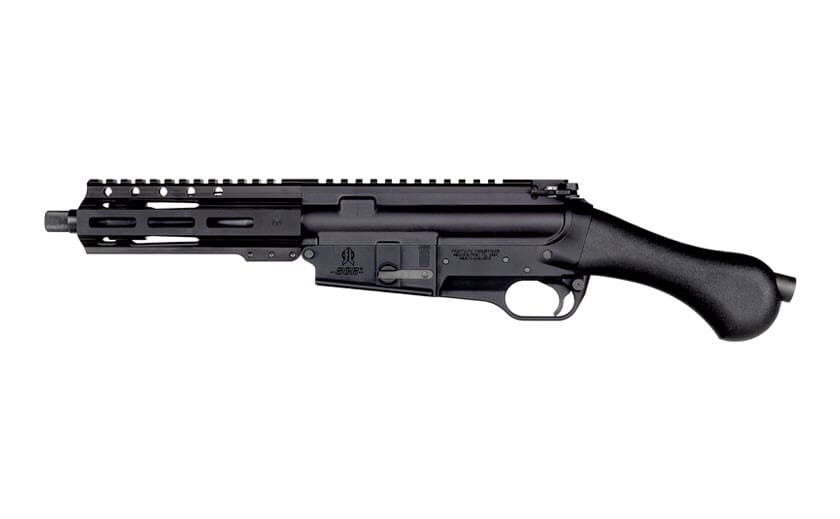
In addition to exhibiting its exciting new FightLite® Raider™ Pistol, the company will also showcase its flagship 8.5 lb. select-fire Squad Automatic MCR® that shares the excellent ergonomics of the M4A1 and which feeds reliably from both M27-linked ammunition belts and standard M16 magazines at operator discretion. Featuring reliable gas-piston operation and a tool-less quick-change barrel system; the patented MCR® is the lightest and most portable belt fed machine gun in the world. Optionally available as an upper receiver upgrade “kit” that retrofits to all MIL-Spec AR15/M16 and M4 lower receivers, the MCR® can also be purchased in a semi-auto configuration for civilian users.
There’s a product for everyone at the FightLite® booth this year including the innovative and patented SCR® (Sport Configurable Rifle) which is not only legal almost anywhere in America including New York City and California, but is the only rifle to have ever successfully combined the traditional lines of a hunting pattern rifle with the modularity and caliber options of an AR-15 type rifle.
The SCR® blends the strength, reliability, accuracy and rugged all-weather characteristics of America’s longest serving infantry rifle with the classic lines of an American sporter. Lightweight, accurate and featuring a MIL-STD 1913 flat top upper receiver that accepts most modern optics, the SCR® is designed to perform under the most demanding field, competitive shooting or tactical conditions and its multi-caliber, modular design permits sportsmen to instantly change calibers in the field by simply pressing two pins and exchanging one upper receiver assembly for another.
To learn more about innovative products from FightLite® Industries including its new and highly efficient RipBrake™ muzzle compemsator, please visit Booth #12971 at this year’s SHOT Show.

SMYRNA, GA. – Jan 2, 2018 GLOCK, Inc., announces today the addition of the GLOCK 26 and the GLOCK 34 Modular Optic System (MOS) to the Generation 5 pistol family, bringing the number of 9×19 caliber pistols in the Gen5 family to four.
The G26 Gen5 and G34 Gen5 MOS continue the evolution of perfection with over twenty design changes to distinguish them from their Gen4 predecessors. Through rigorous testing and development, GLOCK has combined the historical reliability and trust in the brand with precisely-engineered design changes to meet the demand of consumers world-wide.
“The development of our Gen5 pistols was the result of the constant pursuit of perfection and a desire to meet the requests of the consumer market,” said GLOCK, Inc. VP Josh Dorsey. “We have combined the standards of high-level performance and reliability with distinctive design enhancements to improve durability, accuracy, and performance. The benefits enhance the shooter experience at the range and in high-stress situations where fractions of a second matter.”
Among the design enhancements are the GLOCK Marksman Barrel (GMB) which delivers increased accuracy with enhanced polygonal rifling and an improved barrel crown, no finger grooves, ambidextrous slide stop levers for better versatility and control, and an nDLC finish, which is a tougher and more durable finish that is exclusive to the GLOCK manufacturing process.
The G26 Gen5 and the G34 Gen5 MOS will be available on dealer shelves beginning January 22nd, 2018.
For more information about the new generation of GLOCK pistols, contact GLOCK, Inc., or go to us.glock.com.
There have been rumors for months that GLOCK planned to release their Modular Handgun Submission to the public. The marketing plans behind unveiling a new product can rival that of a full scale military invasion, but rarely do they survive contact with the fan base. This is what happened to GLOCK late last week, when a development page for what has been dubbed the G19X, was found on their website. Very quickly, several firearm websites posted what information they knew. Understandably, GLOCK took down the page and hid the video.
But, GLOCK did a great job of pivoting. They revamped the site and added a countdown clock to the pistol’s official launch at SHOT Show. They also sent out this press release earlier this morning.
SMYRNA, GA. – Jan 2, 2018 GLOCK, Inc., today introduces their first ever “Crossover” pistol, the GLOCK 19X, which combines the best features of two of its most popular and most trusted field-tested platforms. The full-size GLOCK 17 frame and the compact GLOCK 19 slide have joined forces for the ideal pistol for all conditions and all situations.
“The G19X was developed for the military and is a practical everyday pistol that will do what you need it to do, when you need it to; every time, in every condition,” said GLOCK VP Josh Dorsey. “Using GLOCKs combat proven experience with consideration to efficiency, dependability and durability, and through rigorous testing, the G19X stands out above the competition and has the ability to function in harsh climates and all conditions with increased accuracy and ultimate reliability. Our goal was to meet the demanding needs of the military while maintaining our standard of perfection,” said Dorsey. “With proven testing results and fewer parts than our competitors’ pistols, the G19X has maximum efficiency, reliability and is easy to maintain.”
Confidence now comes in a different color with the first-ever factory colored slide. The GLOCK 19X’s improved nPVD slide coating prevents corrosion, resists chemicals, and stands up against the elements. The pistol comes in coyote color and includes a standard 17-round magazine and two 17+2-round magazines along with a coyote-colored pistol case.
Among the additional design features of the G19X are the GLOCK Marksman Barrel (GMB) which delivers increased accuracy with enhanced polygonal rifling and an improved barrel crown, no finger grooves, ambidextrous slide stop levers for better versatility, and a lanyard loop.
The aggregate effect of all the G19X design enhancements gives any user the confidence to succeed and survive in all situations. A perfect “Crossover to Confidence”.
The G19X will be available on dealer shelves beginning January, 22nd, 2018 at select dealers.
For more information about crossing over to confidence with the GLOCK 19X, visit 19X.GLOCK.US.
In addition to the 19X, GLOCK will also release a Gen5 26 and a Gen5 34 MOS. I for one, will be purchasing a G19X when they become available.
 Modular Handgun System is a joint program, with all four services set to eventually field the M17/M18. Air Force pilots carry a sidearm while flying as part of their survival gear. Consequently, the Air Force Operational Test And Evaluation Command has decided to submit MHS to egress testing in order to see if it is compatible with equipment worn by pilots while ejecting from their aircraft and if it will still function after being subjected to those forces. This is the first time they’ve conducted such a test.
Modular Handgun System is a joint program, with all four services set to eventually field the M17/M18. Air Force pilots carry a sidearm while flying as part of their survival gear. Consequently, the Air Force Operational Test And Evaluation Command has decided to submit MHS to egress testing in order to see if it is compatible with equipment worn by pilots while ejecting from their aircraft and if it will still function after being subjected to those forces. This is the first time they’ve conducted such a test.
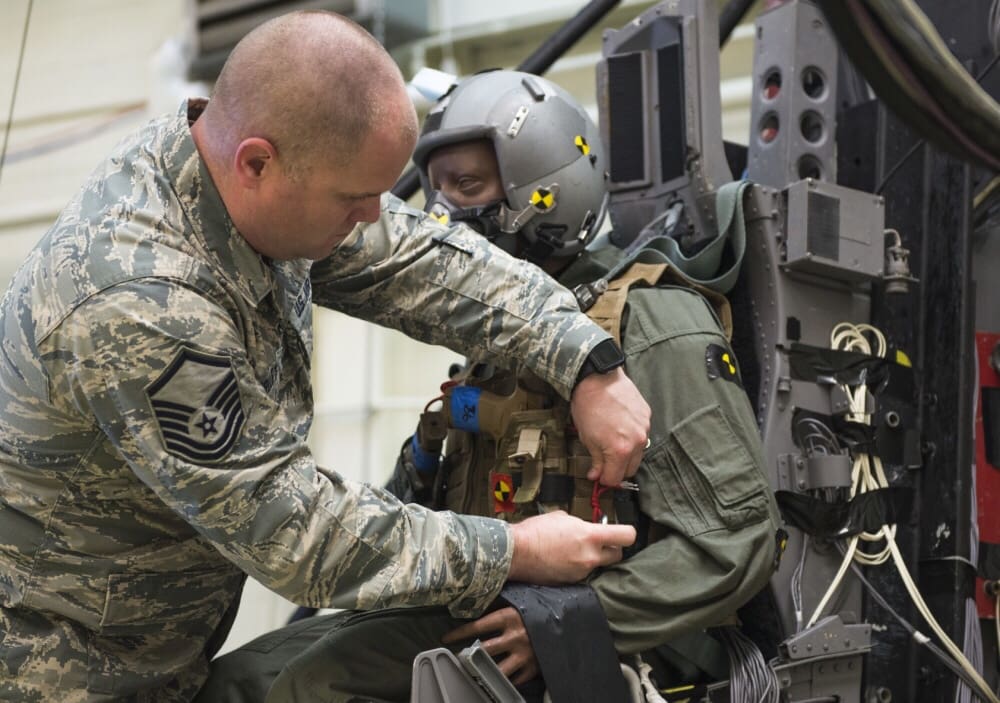 Above, MSgt Samuel Pruett, Air Force Operational Test and Evaluation Center force protection program manager, based at Eglin AFB, Florida, secures an MHS on a test dummy prior to a test on the vertical deceleration tower inside the 711th Human Performance Wing at Wright-Patterson Air Force Base, Ohio, December 6th, 2017.
Above, MSgt Samuel Pruett, Air Force Operational Test and Evaluation Center force protection program manager, based at Eglin AFB, Florida, secures an MHS on a test dummy prior to a test on the vertical deceleration tower inside the 711th Human Performance Wing at Wright-Patterson Air Force Base, Ohio, December 6th, 2017.
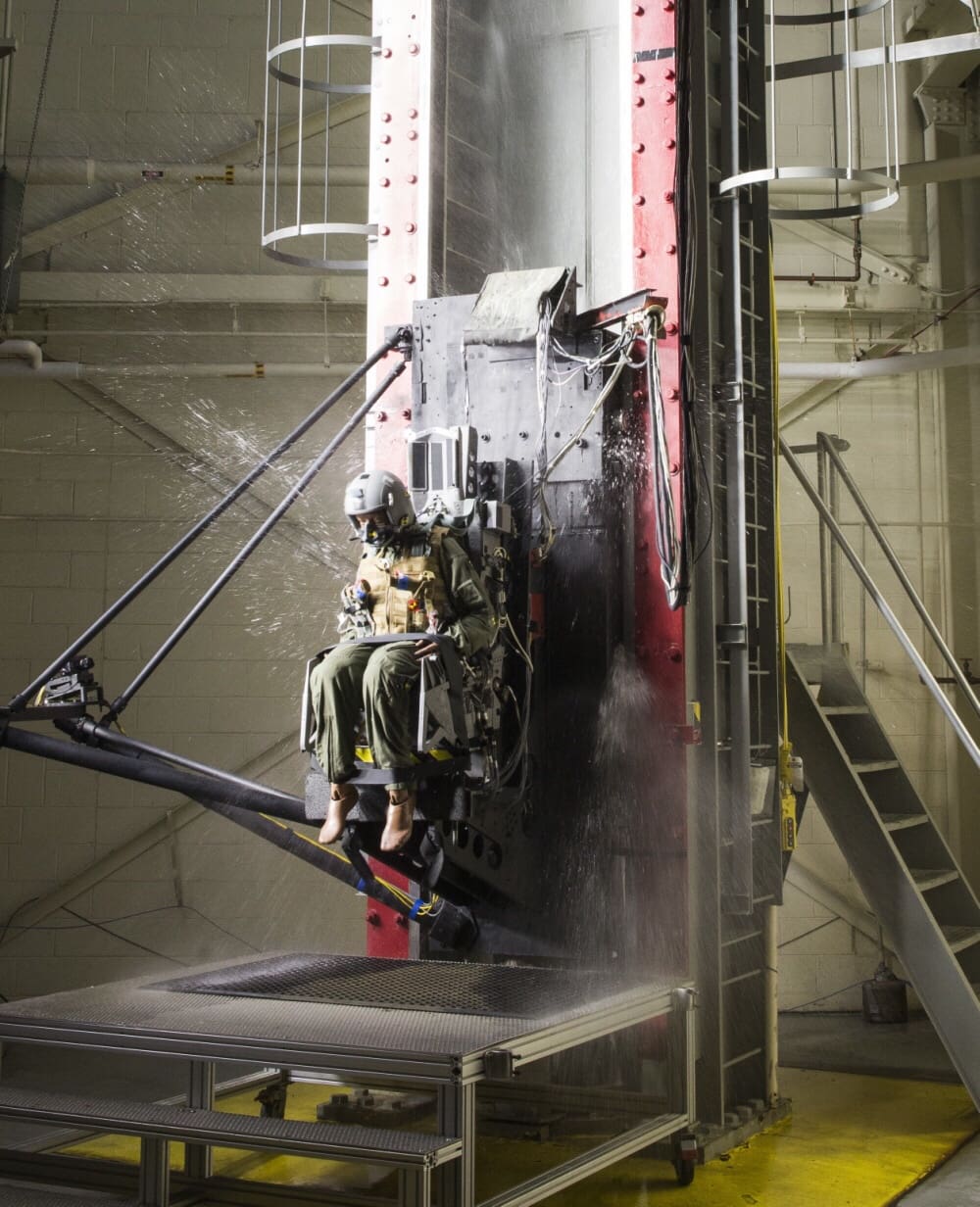 The vertical deceleration tower replicates ejection forces. As you can see, they tested two pistols at once, one with the 17 round magazine and the other with the 21 round magazine.
The vertical deceleration tower replicates ejection forces. As you can see, they tested two pistols at once, one with the 17 round magazine and the other with the 21 round magazine.
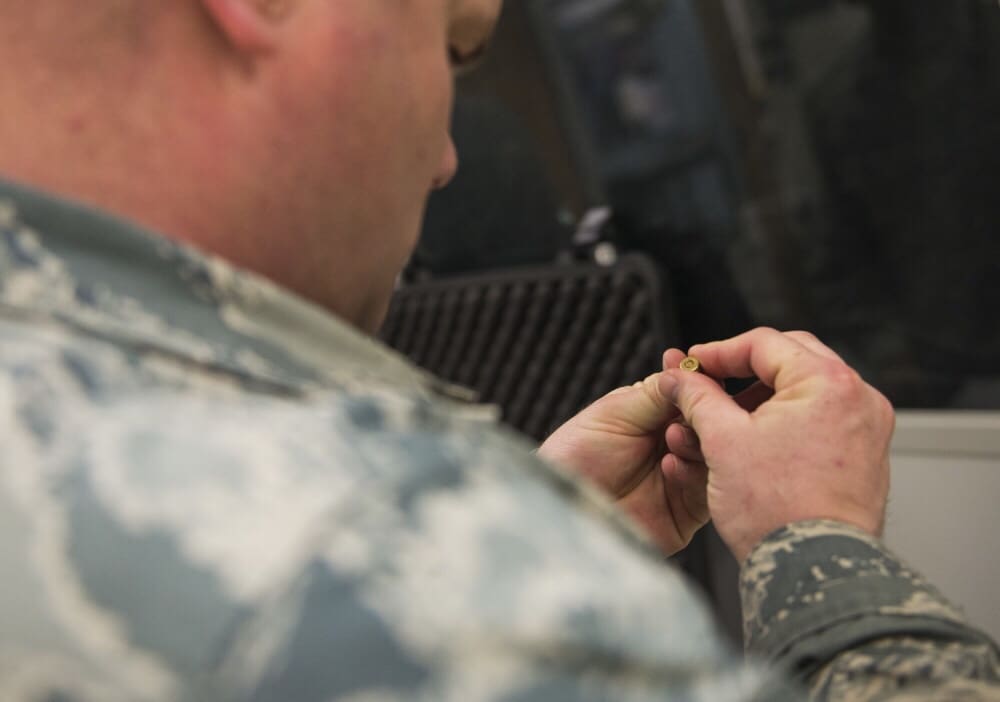 Here, MSgt Pruett checks an empty shell casing from a weapon for signs of the firing pin striking the primer at the conclusion of a test to ensure the weapon didn’t fire as a result of ejection forces.
Here, MSgt Pruett checks an empty shell casing from a weapon for signs of the firing pin striking the primer at the conclusion of a test to ensure the weapon didn’t fire as a result of ejection forces.
Air Force photos by Wesley Farnsworth, 88th Air Base Wing/Public Affairs.